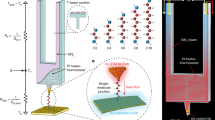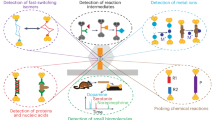Abstract
The development of molecular-scale electronic devices has made considerable progress over the past decade, and single-molecule transistors, diodes and wires have all been demonstrated. Despite this remarkable progress, the agreement between theoretically predicted conductance values and those measured experimentally remains limited. One of the primary reasons for these discrepancies lies in the difficulty to experimentally determine the contact geometry and binding configuration of a single-molecule junction. In this Article, we apply a small-amplitude, high-frequency, sinusoidal mechanical signal to a series of single-molecule devices during junction formation and breakdown. By measuring the current response at this frequency, it is possible to determine the most probable binding and contact configurations for the molecular junction at room temperature in solution, and to obtain information about how an applied strain is distributed within the molecular junction. These results provide insight into the complex configuration of single-molecule devices, and are in excellent agreement with previous predictions from theoretical models.
This is a preview of subscription content, access via your institution
Access options
Subscribe to this journal
Receive 12 print issues and online access
$259.00 per year
only $21.58 per issue
Buy this article
- Purchase on Springer Link
- Instant access to full article PDF
Prices may be subject to local taxes which are calculated during checkout




Similar content being viewed by others
References
Seminario, J. M. Molecular electronics: Approaching reality. Nature Mater. 4, 111–113 (2005).
Reed, M. A. Molecular electronics: Back under control. Nature Mater. 3, 286–287 (2004).
Tao, N. J. Electron transport in molecular junctions. Nature Nanotech. 1, 173–181 (2006).
Heath, J. R. Molecular electronics. Annu. Rev. Mater. Res. 39, 1–23 (2009).
Lindsay, S. M. & Ratner, M. A. Molecular transport junctions: Clearing mists. Adv. Mater. 19, 23–31 (2007).
Zhirnov, V. V. & Cavin, R. K. Molecular electronics: Chemistry of molecules or physics of contacts? Nature Mater. 5, 11–12 (2006).
Haiss, W. et al. Precision control of single-molecule electrical junctions. Nature Mater. 5, 995–1002 (2006).
Demir, F. & Kirczenow, G. Communication: Identification of the molecule–metal bonding geometries of molecular nanowires. J. Chem. Phys. 134, 121103 (2011).
Demir, F. & Kirczenow, G. Identification of the atomic scale structures of the gold-thiol interfaces of molecular nanowires by inelastic tunneling spectroscopy. J. Chem. Phys. 136, 014703 (2012).
Paulsson, M., Krag, C., Frederiksen, T. & Brandbyge, M. Conductance of alkanedithiol single-molecule junctions: A molecular dynamics study. Nano Lett. 9, 117–121 (2008).
Li, Z. & Kosov, D. S. Nature of well-defined conductance of amine-anchored molecular junctions: Density functional calculations. Phys. Rev. B 76, 035415 (2007).
Hybertsen, M. S. et al. Amine-linked single-molecule circuits: Systematic trends across molecular families. J. Phys. Condens. Matter 20, 374115 (2008).
Muller, K. H. Effect of the atomic configuration of gold electrodes on the electrical conduction of alkanedithiol molecules. Phys. Rev. B 73, 045403 (2006).
Quek, S. Y. et al. Amine–gold linked single-molecule circuits: Experiment and theory. Nano Lett. 7, 3477–3482 (2007).
Li, C. et al. Charge transport in single Au — Alkanedithiol — Au junctions: Coordination geometries and conformational degrees of freedom. J. Am. Chem. Soc. 130, 318–326 (2008).
Li, X. et al. Conductance of single alkanedithiols. Conduction mechanism and effect of molecule–electrode contacts. J. Am. Chem. Soc. 128, 2135–2141 (2006).
Stipe, B. C., Rezaei, M. A. & Ho, W. Single-molecule vibrational spectroscopy and microscopy. Science 280, 1732–1735 (1998).
Hihath, J., Arroyo, C. R., Rubio-Bollinger, G., Tao, N. & Agraït, N. Study of electron–phonon interactions in a single molecule covalently connected to two electrodes. Nano Lett. 8, 1673–1678 (2008).
Paulsson, M., Frederiksen, T. & Brandbyge, M. Modeling inelastic phonon scattering in atomic- and molecular-wire junctions. Phys. Rev. B 72, 201101 (2005).
Lin, L-L., Wang, C-K. & Luo, Y. Inelastic electron tunneling spectroscopy of gold–benzenedithiol–gold junctions: Accurate determination of molecular conformation. ACS Nano 5, 2257–2263 (2011).
Frei, M., Aradhya, S. V., Koentopp, M., Hybertsen, M. S. & Venkataraman, L. Mechanics and chemistry: Single molecule bond rupture forces correlate with molecular backbone structure. Nano Lett. 11, 1518–1523 (2011).
Xu, B., Xiao, X. & Tao, N. J. Measurements of single-molecule electromechanical properties. J. Am. Chem. Soc. 125, 16164–16165 (2003).
Xu, B. Q. & Tao, N. J. J. Measurement of single-molecule resistance by repeated formation of molecular junctions. Science 301, 1221–1223 (2003).
Cuevas, J. C. & Scheer, E. Molecular Electronics: An Introduction to Theory and Experiment Vol. 1 (World Scientific, 2010).
Xia, J. L., Diez-Perez, I. & Tao, N. J. Electron transport in single molecules measured by a distance-modulation assisted break junction method. Nano Lett. 8, 1960–1964 (2008).
Haiss, W. et al. Impact of junction formation method and surface roughness on single molecule conductance. J. Phys. Chem. C 113, 5823–5833 (2009).
Guo, S., Hihath, J., Díez-Pérez, I. & Tao, N. Measurement and statistical analysis of single-molecule current–voltage characteristics, transition voltage spectroscopy, and tunneling barrier height. J. Am. Chem. Soc. 133, 19189–19197 (2011).
Rubio-Bollinger, G., Bahn, S. R., Agraït, N., Jacobsen, K. W. & Vieira, S. Mechanical properties and formation mechanisms of a wire of single gold atoms. Phy. Rev. Lett. 87, 026101 (2001).
Minoni, G. & Zerbi, G. End effects on longitudinal accordion modes: Fatty acids and layered systems. J. Phys. Chem. 86, 4791–4798 (1982).
Frederiksen, T. et al. Exploring the tilt-angle dependence of electron tunneling across molecular junctions of self-assembled alkanethiols. ACS Nano 3, 2073–2080 (2009).
Agrait, N., Untiedt, C., Rubio-Bollinger, G. & Vieira, S. Onset of energy dissipation in ballistic atomic wires. Phy. Rev. Lett. 88, 216803 (2002).
Lin, J. & Beratan, D. N. Tunneling while pulling: The dependence of tunneling current on end-to-end distance in a flexible molecule. J. Phys. Chem. A 108, 5655–5661 (2004).
Meisner, J. S. et al. A single-molecule potentiometer. Nano Lett. 11, 1575–1579 (2011).
Profeta, S. & Allinger, N. L. Molecular mechanics calculations on aliphatic amines. J. Am. Chem. Soc. 107, 1907–1918 (1985).
Leff, D. V., Brandt, L. & Heath, J. R. Synthesis and characterization of hydrophobic, organically-soluble gold nanocrystals functionalized with primary amines. Langmuir 12, 4723–4730 (1996).
Levin, C. S. et al. Chain-length-dependent vibrational resonances in alkanethiol self-assembled monolayers observed on plasmonic nanoparticle substrates. Nano Lett. 6, 2617–2621 (2006).
Haiss, W. et al. Thermal gating of the single molecule conductance of alkanedithiols. Faraday Discuss. 131, 253–264 (2006).
Halgren, T. A. Merck molecular force field . I. Basis, form, scope, parameterization, and performance of MMFF94. J. Comput. Chem. 17, 490–519 (1996).
Acknowledgements
The authors would like to acknowledge support from the National Science Foundation (ECCS-1231915) and the UC Davis RISE program.
Author information
Authors and Affiliations
Contributions
J.H. designed the experimental plan. H.R-R., J.M.A. and Y.L. performed single-molecule conductance experiments. H.R-R. analysed the data. All the authors discussed the results and contributed to elaboration of the manuscript.
Corresponding author
Ethics declarations
Competing interests
The authors declare no competing financial interests.
Supplementary information
Supplementary Information
Supplementary Information (PDF 921 kb)
Rights and permissions
About this article
Cite this article
Rascón-Ramos, H., Artés, J., Li, Y. et al. Binding configurations and intramolecular strain in single-molecule devices. Nature Mater 14, 517–522 (2015). https://doi.org/10.1038/nmat4216
Received:
Accepted:
Published:
Issue Date:
DOI: https://doi.org/10.1038/nmat4216
This article is cited by
-
Controlling piezoresistance in single molecules through the isomerisation of bullvalenes
Nature Communications (2023)
-
Advances in single-molecule junctions as tools for chemical and biochemical analysis
Nature Chemistry (2023)
-
Local cation-tuned reversible single-molecule switch in electric double layer
Nature Communications (2023)
-
Concepts in the design and engineering of single-molecule electronic devices
Nature Reviews Physics (2019)
-
Non-chemisorbed gold–sulfur binding prevails in self-assembled monolayers
Nature Chemistry (2019)



